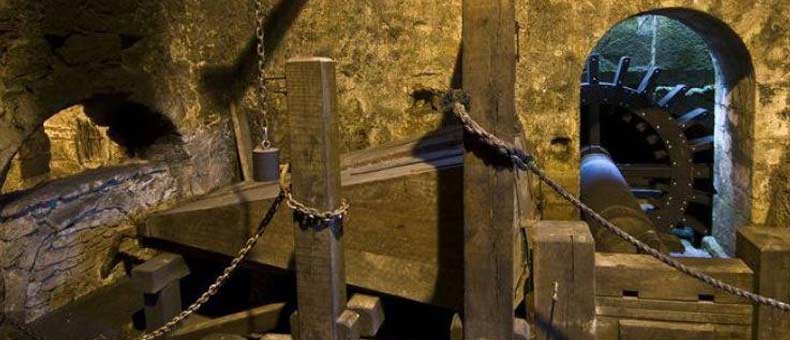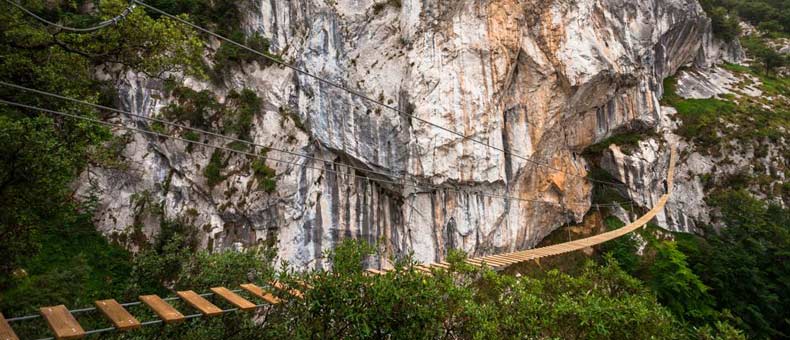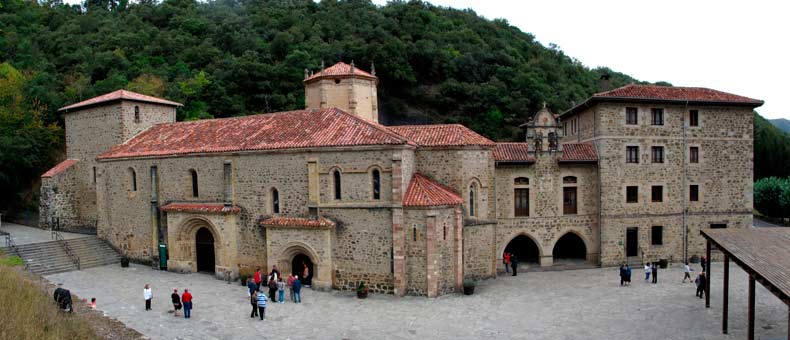The rugged terrain of the Peaks of Europe (Picos de Europa) and the Cordillera Cantábrica delimit the Liébana Valley and it limited the access to Santo Toribio from the neighboring communities of Asturias, Castilla and Leon. Despite this, there are abundant historical references that support the existence of four main pilgrimage routes to the Monastery of Santo Toribio. Signed recently as PR (Routes of small journey) within the Liébana Trails Network, these paths run through different paths according to the area of origin:
The Lebaniego road runs between San Vicente de la Barquera and the Monastery of Santo Toribio, crossing the towns of San Vicente de la Barquera, Val de San Vicente, Herrerías, Lamasón, Peñarrubia, Cillorigo, Potes and Camaleño. It offers the pilgrim a tour of natural sites of great beauty, with examples of capital of the architectural heritage of Cantabria. It also allows to join the North path (or coast road) and the French path to Santiago road from the Leonese and Palentinian routes that recall the historical ties of the diocese of Liébana with the kingdoms of Leon and Castile. The Lebaniego road has a specific credential and a document accrediting the pilgrimage, called la Lebaniega. There are many pilgrims who direct their steps towards Santo Toribio, then connecting the two roads of Santiago in order to win both jubilees
Stage 1. San Vicente-Cades (28Kms)
We begin visiting the church of Nuestra Señora de los Ángeles which is Gothic and was built at the same time with the wall and the castle as it mentioned in the town’s scripts. Inside the church the alabaster tomb of the inquisitor Antonio del Corro masterpiece of the XVI century, one of the best pieces of Spanish renaissance art. We enjoy a panoramic view at this point of the town that is spectacular, on clear days our gaze reaches the Naranjo de Bulnes in the rotund Peaks of Europe (Picos de Europa). Next to the church remains of the “Hospital de la Concepción”, XV-XVI century, ancient shelter for pilgrims of the Santiago road. Continuing along the street and before returning to the Santaiago Road, to the right we leave the building of the town hall, former palace, home of the Corro family XVI century.
San Vicente de la Barquera is one of the most touristic and important towns of Cantabria and has although apart from the path other points of interest such as, the King’s Castle XIII century, the Convent of San Luis XV century where Carlos V was hosted in 1517 to be crowned king; the Bridge of the Maza and the Sanctuary of the Barquera (Santuario de la Barquera), both also of XV century.
From San Vicente, continuing towards Serdio (about 8 km), we leave behind a blue and green landscape so that the latter covers intensity as it passes through La Acebosa, Hortigal and Estrada with its Medieval Tower, Gothic style, from the 14th century , part of a defensive set with moat, fence, tower and chapel.
Two Kilometers before Muñorrodero The Santiago road forks. A route passes through the Lebaniego road to Santo Toribio, towards the French Path, crossing the Vadinian(Vadiniense) route. Another route follows the Coast, along the Northern Road.
Along the Lebaniego Road there is a mountain trail leading to Muñorrodero from where the 7-km Nansa River Trail runs, which runs somberly between varied trees and wooden fable walkways.
In Cabanzón stands out its Medieval Tower, a feudal vestige part of a defensive system of the zone of influence of San Vicente de la Barquera. The original one is VIII century but only conserve the walls of the XV century, We will Visit it.
We finish the stage in Cades. The Ferrería de Cades is a point of interest. The building was completed in 1752 and is part of a gathering of singular complexity. The water was captured at a height of 1000 m to transport it through a canal and thus move two flour mills besides the ironworks. Guided visit.

Stage 2. Cades-Cabañes (30.53Kms)
We leave from Cades and pass through Sobrelapeña to get to La Fuente, where we will find one of the jewels of the Romanesque art in Cantabria: The Church of Santa Juliana, Listed as a building of Cultural Interest. Dating from the late nineteenth and early seventeenth centuries, Romanesque with influences of the protogotic like pointed arches.
A few meters to the right we ascend to Burio and then to the Collado de Hoz, with a panoramic view of the beautiful valley of Lamasón, from where we started descending 1.8 km until Cicera.
From Cicera to Lebeña for 9.6 km we run through a forest of oaks, beeches with millenary specimens and, in season, mushrooms of all kinds can be found and its the cause of almost all the deaths, specially the amanita faloides mushroom.
We go down to Santa María de Lebeña which holds one of the Pre-Romanesque Spanish Jewels. A Mozarabic temple named like the of the locality, built in the year 925 by Christians that fleed from Arab territory, who implement tools learned in the South of the Peninsula, such as the horseshoe arch, etc.
Continue to Allende by road, then drive up to Cabañes. If we are not going to spend the night in Cabañes we have two other alternatives to arrive before the Villa de Potes: First option is to continue along the cliff of the Hermida with the danger that this entails since it is a very narrow road with a lot of traffic, another option is, right at the intersection to Allende, take a path that is on the left and that takes us directly to the Habario with its thousand year old chestnut trees.

Stage 3. Cabañes-Santo Toribio (13.7Kms)
From Cabañes we go to the Habario and then to Pendes where we have tasting and sale of some of the typical Cheese of Liébana (Quesucos de Liébana). We take strength to descend to the hermitage of San Francisco.
This road leads us to Tama. In Tama we highlight his Church with Romanesque remains. Then it is worth going back 1500m on the road (Camino) to visit the Interpretation Center of the Peaks of Europe (Picos de Europa). On the way back to Potes we can avoid the road taking the Campañana road, a parallel walk that ends in the center of the Villa with all its architecture.
In Potes we will find the Infantado Tower (La Torre del Infantado), the most symbolic building of Potes and the most outstanding of Cantabria, forming a beautiful picture with the background Peaks of Europe (Picos de Europa).
It is a house tower of the s. XV. It belonged to Orejón de la Lama and later to the Marquess of Santillana and Duke of the Infantado. He performed military functions. It presides over the old town, declared Historic-Artistic Ensemble. And it is a good start to visit other places of interest such as bridges, emblazoned houses as well as Roman pavement in the old town, wine area, tapas and numerous restaurants offering the typical lebaniego stew (cocido lebaniego).
From Potes we leave for the Monastery of Santo Toribio (4.2 km) to finally venerate the Lignun Crucis. The monastery is s. XIII and s. XVIII, of classic Gothic style and baroque. It houses the door of the pardon, s.XV. that the Vatican opens each year Saint Lebaniego, that is to say, every year that on April 16 coincides with Sunday, the anniversary of the monk Santo Toribio, a historical figure known for bringing the Lignum Crucis to Liébana, a relic that is considered the rest more great of the Cross of Christ.
The monastery has guided tours every summer. In Santo Toribio, end of the Lebaniego Road.

